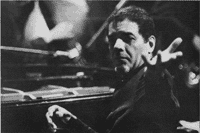Download the Brochure in PDF Format
The Lydian Chromatic Concept of Tonal Organization
George Russell's book, The Lydian Chromatic Concept of Tonal Organization, first published in 1953, was the first theoretical contribution to come from jazz, and was responsible for introducing modal improvisation which resulted in the seminal recording of Miles Davis' "Kind of Blue."
Since it's publication, there have been scores of books on the market which have "borrowed" bits of the Concept's information, but there is only one original.
"[The Concept] was the great path-breaker for Miles Davis and John Coltrane's modality."
- Joachim Berendt, The Jazz Book.
GEORGE RUSSELL'S LYDIAN CHROMATIC CONCEPT OF TONAL ORGANIZATION,
first described in a self-published pamphlet in 1953, marks a radical expansion of the harmonic language for both composition and analysis and also marks an abandonment of the major-minor system which dominated Western music for over 350 years. Radical as it may be, the theory is more than one person's eccentricity, having considerable precedent in the work of Ravel, Scriabin, Debussy and in some of the learned works of Bach. The word "Lydian" is here derived from one of the classical Greek scale modes. Russell's root scale follows the natural overtone series and runs from C to C with F sharp, rather than the customary F natural of the major scale.
For searchers like Miles and Coltrane and Bill Evans, and many in the generations that followed them, Russell's theory provided a harmonic background and a path for further exploration. It also gave rise to the "modal" jazz movement that enjoyed great popularity in the 70's and 80's for better and for worse. We should not underestimate the extent of Russell's enterprise. His work stands head-to-head with Arnold Schoenberg's "liberation" of the twelve-tone scale, the polytonal work of Stravinsky, and the ethnic scale explorations of Bartok and Kodaly. If you've listened to jazz during the last fifty years, you've heard a good deal of George Russell's ideas; he is one of the 20th century's great originals and one of its bravest innovators.
Having finished this work, Russell is completing another volume on related elements which he has been simultaneously developing over the last several decades.
The Lydian Chromatic Concept of Tonal Organization was expanded several times over the years, and has grown greatly since its first appearance in 1953. It is with pride and pleasure that we present this fourth and final edition.
 Click here to visit www.lydianchromaticconcept.com for more information on George Russell's book "George Russell's Lydian Chromatic Concept of Tonal Organization.
Click here to visit www.lydianchromaticconcept.com for more information on George Russell's book "George Russell's Lydian Chromatic Concept of Tonal Organization.

"When you get a whole band to play like that, it's some of the most beautiful music you can have in the world. If you could sit down and write stuff like that out...well, some people do, like George Russell. He wrote stuff like that and it was incredible."
Rashied Ali, Modern Drummer, January, 2003.
“The Lydian Chromatic Concept is one of the two most splendid books about music; the other is My Musical Language by Messiaen. Though I’m considered a contemporary music composer, if I dare categorize myself as an artist, I've been strongly influenced by the Lydian Concept, which is not simply a musical method--we might call it a philosophy of music, or we might call it poetry.”
Toru Takemitsu, Swing Journal interview, Tokyo.
“The simple melody was an experiment inspired by an evening Miles had spent with...George Russell who at the time was working on his...Lydian Chromatic Concept...Miles was fascinated by Russell’s approach. Here was a means for breaking free from tonal cliches while maintaining some amount of restraint. Shortly after his evening with Russell, Miles recorded his new composition demonstrating Russell’s basic principles.”
Round About Midnight: A Portrait of Miles Davis by Eric Nisenson, Dial Press, New York.
“Consider the circumstances. Miles took his musicians into the studio for the first of two sessions for Kind of Blue in March, 1959. At the time modal jazz...was not an entirely new idea...Originally, the idea for this kind of playing with the concept of composer George Russell.”
Liner notes for Kind of Blue by Robert Palmer, Columbia 1355.
“Russell is responsible for what remains the most significant single theoretical treatise written about the music.”
Morton and Cook, The Penguin Guide to Jazz, Penguin Books. London.
“Surpasses any musical knowledge I’ve been exposed to.”
Ornette Coleman
“Gives you so much more to work with.”
Eric Dolphy
“George enlightened me about a different way of playing music, an analytical way which enabled me to go on learning about music on my own.”
Jan Garbarek
“The foremost theoretical contribution of our time---destined to become the most influential philosophy of the future.”
David Baker
“Far ahead of any book in the field.”
Gil Evans
“The past, the present, the future, all in one. A must for the serious musician.”
Art Farmer
“Miles Davis became the first major jazz musician to be influenced by Russell’s ideas, and in 1958 he composed...Milestones, which was based on two modes...He recorded Milestones with Coltrane on April 3, 1958, and both men felt liberated by the new harmonic philosophy. Davis continued to work on Russell’s concepts, and...he created five selections for the first all-modal album, Kind of Blue.”
Stan Getz: A Life in Jazz by Donald Maggin, William Morrow, New York.
“It is indeed quite possible that much of the jazz rock of the seventies would not have existed if it weren’t for Russell’s pioneering work.”
Eric Nisenson, Music and Sound Output.
“The first work deriving a theory of jazz from the immanent laws of jazz, not from the laws of European music. The Concept was the great path-breaker for Miles Davis’ and John Coltrane’s modality.”
The Jazz Book by Joachim Berendt, Lawrence Hill Books, Chicago.

